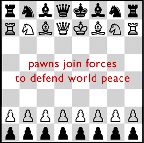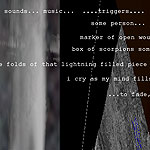:: Wednesday, July 13, 2005 ::

PROJECT REVIEWS:: THE WAR ON TERROR
What to Do without Dialogue in These Times
BY: Molly Hankwitz
Art is an antidote.
These projects foster peace and the human purpose of cultural and social exchange:
::
'Dialog Table'---A shared interface in which more than one person is capable of engaging in dialogue about the films, images and interactive elements embedded in the design, each others thoughts and topics of the art therein; a physical manifestation for face2face communication about culture and life.
'gender[f]'---is a feminist collaboration dedicated to the over 400 murdered and disappeared women of Juarez who worked in the maquiladoras of Juarez.
This project arises from the unseemly juxtaposition of a "war on terror" with the every day realities faced by women living in cultures that enforce female circumcision, do not give equal value for equal work based on cultural bias, tacitly accept violent domestic situations, use sexual intimidation as a military tactic and fear of reprisal as a cultural control.
'Rethinking Wargames' ---by Ruth Catlow, sets out to alter the militaristic design of traditional chess and, therefore, to question the underpinnings of war mentality in the player and society at large.
:::
Additional links:
Interview with Ruth Catlow/A Chance to Remaster Conflict
Note: Invited guest editor Ana Boa Ventura's project on new media and net.art degree programs has been postponed. Please stay tuned to other net.art.review Weekly features each Wednesday--mh

PROJECT REVIEW::
Carrizo-Parkfield Diaries
BY: Eduardo Navas
The following review should be considered with humans' desire to control catastrophes, whether they are man-made or natural. It is the loss of control that makes both types of events in part tragic and painful.
The Carrizo-Parkfield Diaries is a collaboration by (in alphabetical order) Jeremy Hight, Christina McPhee, and Sindee Nakatani. It consists of live microseismic data that is downloaded in hourly compilations from a California site which records seismic movements. The official description reads:
Drawing from live, micro-seismic measurements of peak ground velocity, peak ground accceleration and spectral response, we compile hourly updates into number sequences that, in turn, 'crash' into an archived seismic database from a recent quake.
Upon entering the site one encounters an interface created with Flash technology. The first thing the viewer will experience is the process of a file loading. Once the file runs, one views a short abstract animation which is defined according to the data that is downloaded "live" from the online resource which archives the seismic movements. The images are photographs taken on location at Carrizo about 150 miles away from a parkfield, where a major earthquake happened in September 28, 2004. These images have been altered to become more or less abstractions that still carry a trace of their origin. Then a set of numbers which correspond to the data that is downloaded to trigger the "crash" (that is the short animation) is briefly seen, and another file is loaded following the same process. Another animation runs. And another one. Each live animation is complemented by a sound file consisting of short piano and string instrument loops. Each animation is also accompanied by text, which is more or less an abstract narrative exploring feelings of longing, fear and uncertainty, as well as hope. Some of the lines of text read:
"he had a scar on his finger...
...a half moon... from a knife... cutting melons as a boy...
a physical memory..."
and then it disappears; then another text reads:
"Certain sounds... music...
...triggers... some person...
marker of open wounds by guitar or synth line..."
While the concept of the Carrizo Parkfield diaries is very appealing its delivery is not always effective. For one thing the site demands a fast Internet connection, as it takes time to load the files that will be presented as "live" crashes. In the beginning, the viewer will spend most of her time watching the files loading, and once loaded it is not easy to read the text while also viewing the abstract imagery. This demands that the viewer watch the files more than once, and indeed the avid viewer will most likely wait to have the text appear again. This at least was my case because I understand how Flash technology works; however, this cannot be assumed of the average user. Regardless, assuming that the viewer is willing to stay, say twenty minutes with the site, once all the animations have been loaded the files move too fast and while in the beginning one spent most of the time waiting for the file to load, now one spends time swiftly moving from file to file because they have all been cached on the computer. Then there is not enough time to read the text. And the original pacing is then switched for one that is more typical of Flash downloads, where the viewer barely notices the download bar, and goes practically straight to the animation. and here, the animation feels very different then when it was originally dowloaded.
Other things to consider are how the imagery and sound relate to the concept of earthquakes. While the visuals are originally photographs from the place where a major earthquake happened and closely related with the data responsible for triggering the animations, why they look the way they look is not clear. Even when knowing the premise of the project, it is hard to understand the logic supporting the process towards abstraction. Why the sound was chosen is not clear as well.
But to do justice to the piece some of the answers to these questions can be found in the official statement:
Conceptually, the current data's reach into the past changes the archive from a static resource to an uncanny future array: layers of fiction trigger from the disturbances, much like the way human memory reconfigures itself after shock.
With this in mind, then, we can understand the driving force behind the diaries. It is the desire to understand the sublime. The earthquake today as in the past is "unconquerable," it cannot be tamed. Striving to do this is a futile effort by seismologists. All they can do is keep track of earthquakes to better understand how they occur, but at no point would they hope to control them--at least not in the near future. In a sense, the Carrizo-Parkfield Diaries extend this premise as an online project. It is an honest attempt at the desire to domesticate nature--a desire which is publicly presented as a gesture towards knowledge in the name of progress. The texts struggling to make sense against animated abstractions complemented with short sound loops are more or less an illustration of humans' fear of losing control because we do not fully understand the seismic process or, even more honestly, ourselves.
Sites:
http://artport.whitney.org/gatepages/march05.shtml
http://www.carrizoparkfielddiaries.net/
Christina McPhee
http://www.christinamcphee.net/
Jeremy Hight
http://www.34n118w.net/
Sindee Nakatani
(no site available)